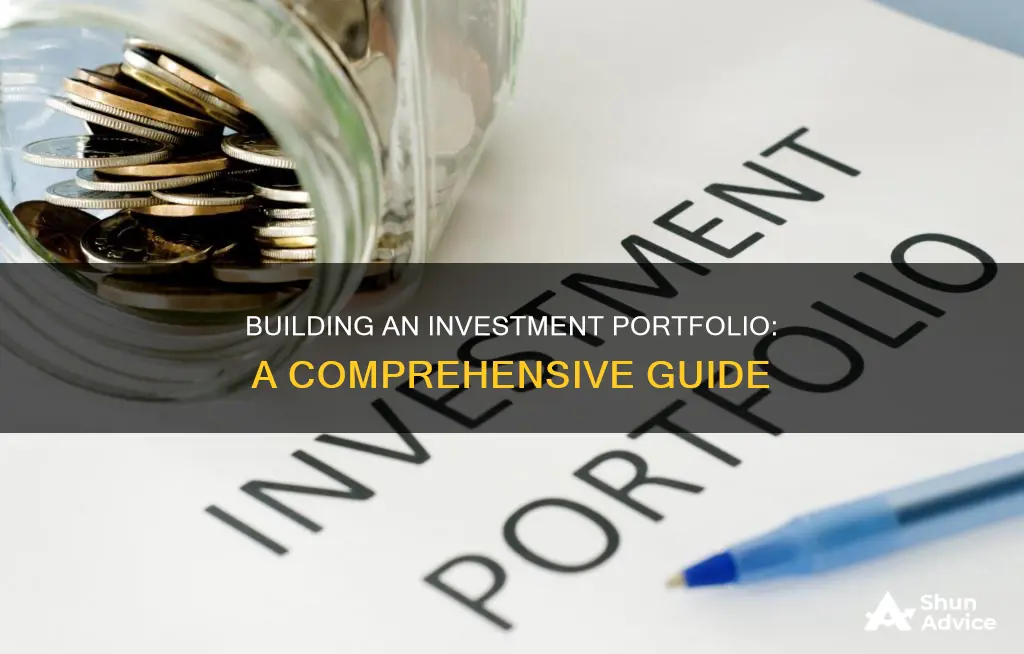
Building an investment portfolio can be a daunting task, but with the right tools and knowledge, it can be a rewarding endeavour. For those looking to educate themselves on the topic, there is a wealth of literature available, ranging from the general to the highly specialised. Investing Demystified by Lars Kroijer is one such example, offering straightforward and jargon-free advice on how to build a successful investment portfolio. The book emphasises the importance of diversification and a long-term perspective, while also providing insights into risk management and cost-effective strategies.
For those seeking a deeper understanding, there are numerous books focused on portfolio management, such as Pioneering Portfolio Management and Active Portfolio Management, which offer a more quantitative and comprehensive approach to the topic. These books are geared towards finance students, professionals, and those with domain knowledge, providing valuable insights into the complex world of portfolio management.
Whether you are a beginner or an experienced investor, educating yourself is key to making informed decisions and optimising your investment portfolio.
What You'll Learn

Understanding your risk tolerance and setting your investment goals
Understanding your risk tolerance and setting clear investment goals are crucial steps in building an investment portfolio. Risk tolerance refers to the amount of market volatility and loss an investor is willing to accept. It is influenced by factors such as age, investment goals, income, and future earning capacity. Generally, younger investors with a longer time horizon are considered more risk-tolerant and are more likely to invest in stocks, while older investors tend towards more conservative investments like bonds. However, age is not the sole determinant, as individuals with higher net worth and more liquid capital can afford to take on greater risk.
To assess your risk tolerance, ask yourself the following questions:
- What are your investment goals? Common goals include saving for a child's education, retirement, or financial independence. Understanding your goals will help you gauge how much risk you are willing to take.
- What is your time horizon? This refers to when you plan to use the invested money. Longer time horizons, such as saving for retirement, typically allow for more risk-taking, as there is time to recover from potential downturns. In contrast, shorter time horizons, like saving for a house down payment, require a more conservative approach to ensure capital preservation.
- How comfortable are you with short-term losses? Investments can fluctuate, and stocks may decline in value. If you need access to your funds in the near term, you may have to sell at a loss. A longer time horizon provides the flexibility to hold onto investments, allowing them to potentially recover and increase in value.
- Do you have non-invested savings? It is essential to have savings set aside in liquid accounts for emergencies, regardless of your risk tolerance. However, if a significant portion of your savings remains in cash due to anxiety about investing, it indicates a lower risk tolerance.
- How frequently will you track your investments? If you plan to monitor your investments closely, consider whether it is due to excitement or nervousness. A diversified portfolio focused on long-term goals can help mitigate anxiety associated with market fluctuations.
By thoughtfully considering these questions, you can gain a clearer understanding of your risk tolerance and set more defined investment goals. This knowledge will guide your investment choices and help you build a portfolio aligned with your comfort level and objectives.
Assessing Investment Risk: Measuring Portfolio Riskiness
You may want to see also

Choosing the right investment accounts for your goals
Understand Your Investment Goals
Before selecting investment accounts, it's essential to clearly define your financial goals. Are you investing for retirement, saving for a down payment on a house, or pursuing a specific financial target? Different investment accounts offer varying benefits and features catering to diverse goals. For example, if you're investing for retirement, consider tax-advantaged accounts like pensions or Individual Retirement Accounts (IRAs) that offer tax relief and long-term growth potential.
Evaluate Your Risk Tolerance
Risk tolerance is a key factor in choosing the right investment accounts. Assess your comfort level with risk and how much volatility you're willing to accept in pursuit of potential returns. If you're risk-averse, consider investment accounts that emphasize capital preservation and stable returns, such as those focused on fixed-income investments or conservative portfolios. On the other hand, if you have a higher risk tolerance, you may opt for accounts that primarily hold stocks or more aggressive investment strategies.
Consider the Investment Time Horizon
The time horizon for your investments plays a significant role in account selection. For long-term goals like retirement, you may opt for accounts that offer tax advantages and compound growth over time, such as pension plans or tax-efficient investment accounts. On the other hand, if you're saving for a shorter-term goal, you might choose more flexible investment accounts that allow easier access to your funds without incurring penalties.
Explore Different Types of Investment Accounts
Familiarize yourself with the various types of investment accounts available. Common options include brokerage accounts, retirement accounts (e.g., 401(k)s, IRAs), taxable investment accounts, and tax-advantaged accounts. Each type of account has its own set of rules, tax implications, contribution limits, and withdrawal restrictions. For example, retirement accounts often provide tax benefits but may have restrictions on when you can withdraw funds without penalties.
Assess Fees and Minimum Requirements
When choosing an investment account, pay close attention to the associated fees and minimum requirements. Different accounts may have varying management fees, transaction fees, or account maintenance fees. Additionally, some accounts may require a minimum initial deposit or ongoing contribution requirements. Ensure you understand all the costs involved to make an informed decision.
Diversification and Asset Allocation
Diversification and asset allocation are essential considerations when choosing investment accounts. Diversification helps to mitigate risk by spreading your investments across various asset classes, sectors, and investment vehicles. Consider accounts that allow you to invest in a wide range of assets, such as stocks, bonds, mutual funds, exchange-traded funds (ETFs), and alternative investments. Proper asset allocation ensures your investments are aligned with your risk tolerance, investment goals, and time horizon.
In conclusion, building an investment portfolio requires careful consideration of your financial goals, risk tolerance, time horizon, and the types of investment accounts available to you. By understanding these factors and selecting the right investment accounts, you can take a significant step towards achieving your financial objectives. Remember to regularly review and adjust your portfolio as your circumstances and the market conditions evolve.
Strategies to Diversify Your Investment Portfolio Wisely
You may want to see also

Selecting your investments and asset allocation
Selecting your investments and determining your asset allocation are crucial steps in building an investment portfolio. Here are some detailed instructions and considerations to help you make informed decisions:
Understanding Asset Allocation:
Asset allocation refers to how you divide your investment portfolio among different types of assets, such as equities (stocks), fixed-income assets (bonds), and cash or cash equivalents. The main goal is to balance risks and rewards based on your financial goals, risk tolerance, and investment horizon. Each asset class has distinct risk and return potential, so they will perform differently over time.
Factors Influencing Asset Allocation:
- Financial Goals: Your investment goals will influence your asset allocation. For example, someone saving for a short-term goal like buying a car might favour a conservative mix of cash, certificates of deposit, and short-term bonds. On the other hand, individuals saving for retirement, which is a long-term goal, typically invest a significant portion of their retirement accounts in stocks to benefit from long-term market growth.
- Risk Tolerance: Your comfort level with investment risk is a key factor. If you're averse to risk, you may opt for more conservative asset classes, even if you have a long-term investment horizon. Those with a higher risk tolerance may be comfortable with a larger allocation of stocks or more aggressive investment strategies.
- Time Horizon: The length of your investment horizon, or how long you plan to invest for, will impact your asset allocation. Financial advisors generally recommend holding stocks for five years or longer. Cash and money market accounts are suitable for short-term goals (less than a year away), while bonds are considered a medium-term investment.
- Age: Your age is a significant factor in asset allocation. Traditionally, advisors suggested subtracting your age from 100 to determine your stock allocation percentage. However, with increasing life expectancies, some advisors now recommend subtracting age from 110 or 120. As you approach retirement, shifting towards a more conservative asset allocation is generally recommended to reduce risk.
Implementing Your Asset Allocation:
Once you understand the basics of asset allocation, you can consider different investment portfolios to implement your chosen strategy:
- Income Portfolio: This type of portfolio is designed for capital preservation and typically allocates 70% to 100% to bonds and other fixed-income securities. It's suitable for conservative investors who prioritise protecting their principal investment.
- Balanced Portfolio: A balanced portfolio aims to balance growth and income, usually with an allocation of 40% to 60% in stocks and the remainder in fixed-income securities. This approach is often recommended for long-term retirement investors.
- Growth Portfolio: A growth portfolio focuses on long-term capital growth and is generally more aggressive, with an allocation of 70% to 100% in stocks. This type of portfolio is suitable for investors with a higher risk tolerance and a longer time horizon.
Diversification and Regular Reviews:
Diversification within your chosen asset classes is essential to manage risk effectively. You can further divide your stock allocation by market capitalisation (large-cap, mid-cap, small-cap), geography (domestic vs. international), and alternatives like real estate or commodities. Additionally, remember that asset allocation isn't a one-time decision. Regularly review and adjust your portfolio to ensure it remains aligned with your financial goals, risk tolerance, and changing life circumstances.
Selecting Specific Investments:
When selecting individual investments within your chosen asset classes, consider the following:
- Stocks: Decide whether you want to invest in large-cap, mid-cap, or small-cap stocks. Large-cap stocks are generally considered less risky due to higher liquidity, while small-cap stocks tend to have higher risk and higher potential returns. You can also choose between domestic and international stocks to diversify your exposure.
- Bonds: Fixed-income securities include highly-rated corporate or government bonds. These are less volatile than stocks and provide a steady income stream through interest payments.
- Cash and Cash Equivalents: This category includes short-term debt investments, typically with a maturity of one year or less. Treasury bills are a common example. They offer low risk but also lower returns.
- Mutual Funds and ETFs: Consider investing in mutual funds or exchange-traded funds (ETFs) that provide instant diversification by holding a mix of stocks, bonds, and other assets. Target-date funds, for example, automatically adjust their asset allocation based on your selected retirement year, becoming more conservative as you approach retirement.
Remember, there is no one-size-fits-all approach to selecting investments and determining asset allocation. The key is to understand your financial goals, risk tolerance, and time horizon, and then build a portfolio that aligns with your unique circumstances. Regularly review and adjust your portfolio to ensure it remains on track.
Building a Personal Investment Portfolio: Strategies for Success
You may want to see also

Diversifying your portfolio
Spread the Wealth
It is essential to diversify across different asset classes, sectors, and industries. Equities offer high returns, but avoid putting all your money in one stock or sector. Create a diverse portfolio by investing in a range of companies you know and trust and consider investing in commodities, exchange-traded funds (ETFs), and real estate investment trusts (REITs). Think globally, as investing internationally can help spread your risk and lead to more significant rewards. However, maintain a manageable portfolio; limit yourself to around 20-30 different investments to effectively monitor and manage your holdings.
Consider Index and Bond Funds
Index funds and fixed-income funds can be excellent additions to your portfolio. These funds track various indexes, providing long-term diversification. By including fixed-income solutions, you further hedge your portfolio against market volatility and uncertainty. Index funds often have low fees, which means more money in your pocket. However, their passively managed nature might be suboptimal in inefficient markets.
Keep Building Your Portfolio
Regularly add to your investments. If you have a substantial sum to invest, consider using dollar-cost averaging to smooth out market volatility. This strategy involves investing the same amount of money over time, buying more shares when prices are low and fewer when prices are high. This approach helps reduce your overall investment risk.
Know When to Get Out
While buy-and-hold and dollar-cost averaging are sound strategies, staying informed about your investments and the overall market conditions is crucial. Be vigilant about the companies you invest in, and know when to cut your losses and move on to other opportunities.
Keep an Eye on Commissions
Understand the fees you are paying to brokers or investment firms. Some charge monthly fees, while others have transactional fees. Be aware of what you are paying for and keep updated on any changes to your fee structure. While many online brokers now offer commission-free trading in stocks and ETFs, trading mutual funds, illiquid stocks, and alternative asset classes may still incur fees.
Savings vs Investments: When Does Saving Trump Spending?
You may want to see also

Maintaining and rebalancing your portfolio
Review and Rebalance Regularly
It is important to review your portfolio periodically to ensure it aligns with your investment goals and risk tolerance. While it is not advisable to make frequent trades, reviewing your portfolio helps identify areas that need adjustment. For instance, you may need to rebalance by changing a fund due to a manager switch or poor performance. Regular reviews also help you avoid emotional attachment to underperforming investments, which can lead to losses. As you approach your investment goals or need access to cash, consider 'de-risking' your portfolio to protect your capital.
Long-Term Perspective
Maintaining a long-term perspective is crucial when investing. Short-term speculation carries higher risks, and it is often better to adopt a buy-and-hold strategy. Be patient and avoid making frequent decisions. If the market experiences a significant downturn, view it as an opportunity to add to your holdings rather than sell. This approach aligns with the principle of buying low and selling high, which is a key to successful investing.
Diversification
Diversification is a fundamental aspect of portfolio management. By diversifying your portfolio across different asset classes, industries, and geographic regions, you can reduce risk and improve long-term returns. However, it is important not to over-diversify, as holding an excessive number of stocks may not provide additional benefits. Maintaining a focused selection of investments can be more effective.
Tax Considerations
Tax implications play a significant role in portfolio management. Take advantage of tax-efficient investment vehicles, such as personal pensions and individual savings accounts (ISAs), which offer tax relief and tax-free growth. These vehicles can help maximise your after-tax returns and should be considered when structuring your portfolio.
Risk Management
Understanding and managing risk is essential for maintaining a healthy portfolio. Assess your risk tolerance and ensure your portfolio aligns with it. If you are a conservative investor or nearing retirement, consider reducing your exposure to high-risk investments. Diversification and asset allocation are tools that can help manage risk effectively.
Performance Evaluation
Periodically evaluate the performance of your investments. Assess the returns generated by individual holdings and the portfolio as a whole. If certain investments consistently underperform, consider replacing them with more promising alternatives. However, be cautious when comparing past performance to expected future returns, as historical returns may not always be indicative of future results.
Cost Awareness
Be mindful of the costs associated with trading and managing your portfolio. Frequent trading can incur higher transaction costs and impact your overall returns. While cost should not be the sole factor in your investment decisions, it is an important consideration when maintaining and rebalancing your portfolio.
In summary, effective portfolio management involves regular reviews, a long-term perspective, diversification, tax efficiency, risk management, performance evaluation, and cost awareness. By incorporating these strategies, you can maintain a well-balanced portfolio that aligns with your investment goals and risk tolerance.
Accessing Your ENT Investment Portfolio: A Step-by-Step Guide
You may want to see also
Frequently asked questions
An investment portfolio is a collection of assets that you buy or deposit money into to generate income or appreciate capital. These assets can include stocks, bonds, mutual funds, exchange-traded funds (ETFs), and more.
Your investment goals should be based on your financial objectives and risk tolerance. For example, if you are saving for retirement, you may have a long-term goal of maximizing the growth of your portfolio's value. If you are investing for the short term, your goal may be to preserve capital and generate stable returns.
The key is to diversify your portfolio by investing in a mix of asset classes, such as stocks, bonds, ETFs, mutual funds, and alternative investments. You should also consider your risk tolerance and time horizon when selecting investments. For example, stocks are generally riskier but offer higher potential returns, while bonds are considered safer and provide stable income.
It is important to regularly monitor and adjust your portfolio to ensure it aligns with your investment goals and risk tolerance. This may involve rebalancing your asset allocation by buying or selling certain investments to return to your desired weightings. Life events, such as retirement or a change in income, may also trigger adjustments to your portfolio.







